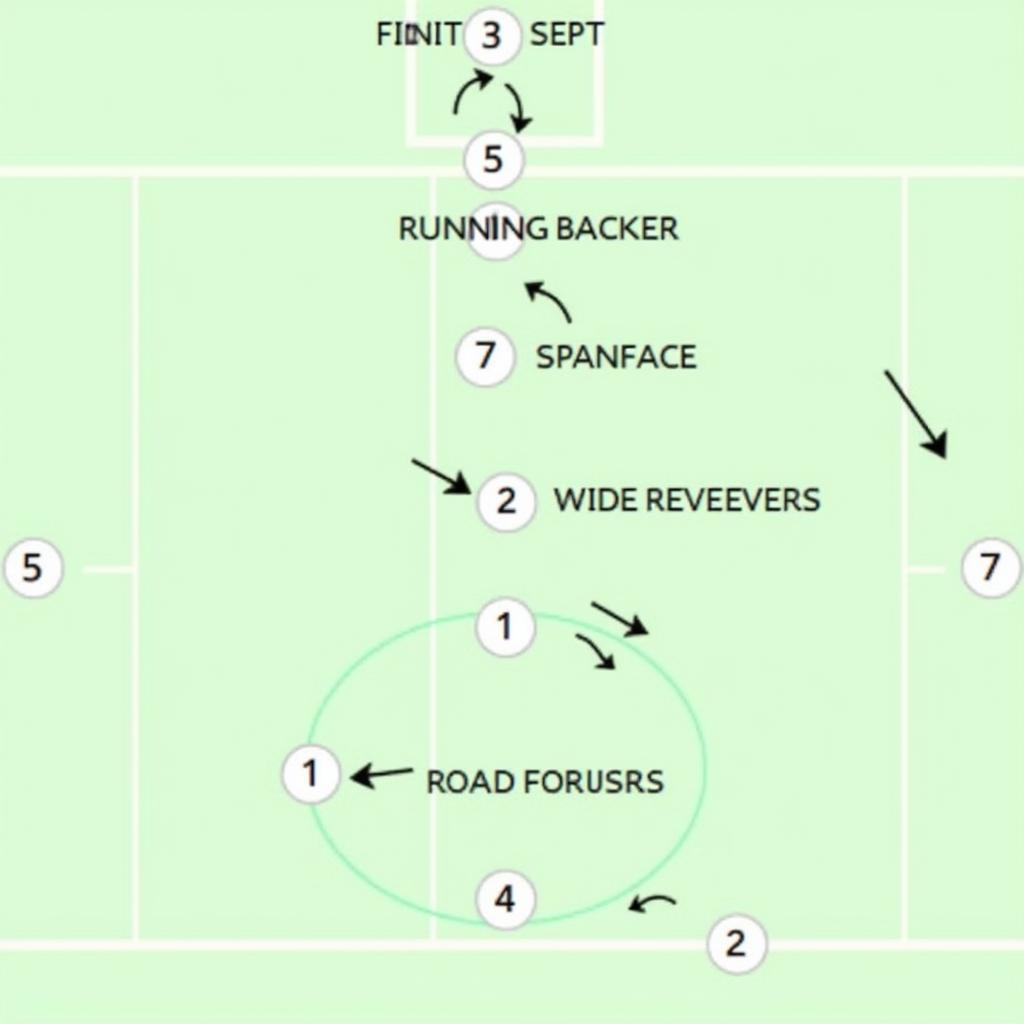Mastering Football Split Back Formation Plays
October 22, 2024The split back formation, a staple in American football, offers a balanced offensive approach that can be strategically advantageous. Whether you’re a seasoned coach or a curious fan, understanding the intricacies of “Football Split Back Formation Plays” can provide valuable insight into this dynamic formation and its various applications.
 Football Split Back Formation Diagram
Football Split Back Formation Diagram
Decoding the Split Back Formation
The split back formation is characterized by its balanced offensive setup. In this formation, the quarterback is positioned under center, with two running backs lined up approximately five yards behind him. This balanced alignment makes it challenging for defenses to predict whether the play will be a run or a pass.
Advantages of Employing the Split Back Formation
The split back formation offers several advantages that contribute to its effectiveness:
- Unpredictability: The balanced positioning of the running backs keeps the defense guessing about the play’s direction.
- Run-Pass Balance: The formation allows for a diverse playbook, incorporating both strong running plays and effective passing options.
- Protection: With two running backs available for pass protection, the quarterback has added security in the pocket.
Key Split Back Formation Plays
1. Inside Zone Run
A foundational play in the split back offense, the inside zone run relies on the offensive line creating a cohesive push to open interior running lanes. The running back aims for a specific gap based on the defensive alignment, capitalizing on any openings created by the offensive line’s surge.
2. Draw Play
The draw play is designed to deceive the defense into thinking the play will be a pass. The quarterback drops back as if to pass, drawing the defensive line forward. At the last moment, the quarterback quickly hands the ball off to a running back, who exploits the space created by the retreating defensive line.
3. Play-Action Pass
Leveraging the run-first tendencies of the split back formation, play-action passes start with a run fake. The quarterback pretends to hand the ball off, causing linebackers and safeties to commit to stopping the run. This action opens up passing lanes for the quarterback to exploit.
Adapting the Split Back Formation
While inherently balanced, the split back formation can be tailored to exploit specific defensive weaknesses:
- Strong-Side Runs: If a defense is particularly vulnerable on one side, the offense can overload the formation with additional blockers to create a numbers advantage for the running back.
- Pass-Heavy Packages: Though known for its run-first approach, the split back formation can effectively transition into a pass-heavy scheme by adding an extra receiver to the field.
Conclusion
The split back formation offers a versatile and effective approach to offensive football. Its ability to seamlessly blend run and pass plays makes it a challenging formation for defenses to counter. By mastering the key plays and adapting the formation to specific game situations, coaches can unlock the full potential of the split back offense.
FAQs about Split Back Formation Plays
1. What is the main difference between a split back formation and other offensive formations?
The key distinction lies in the positioning of the running backs. In a split back formation, both backs are aligned behind the quarterback, while other formations may have backs positioned differently. This symmetrical setup makes the split back formation particularly effective for balancing run and pass plays.
2. Is the split back formation suitable for youth football leagues?
Yes, the split back formation is well-suited for youth football due to its emphasis on fundamentals and straightforward play designs. It allows young players to develop a strong understanding of basic blocking schemes and running lanes.
3. What are some alternative names for the split back formation?
The split back formation is sometimes referred to as the “Pro Set” or the “Double Back” formation. These names highlight the balanced and versatile nature of the formation, often favored by professional and amateur teams alike.
4. Can a team effectively utilize the split back formation if they lack a mobile quarterback?
Absolutely! While a mobile quarterback can add an extra dimension to the offense, the split back formation’s effectiveness doesn’t solely rely on quarterback mobility. Its strength lies in its ability to create a balanced attack, keeping defenses guessing regardless of the quarterback’s running abilities.
5. Are there any resources available for learning more about specific split back formation plays?
Yes, there are numerous resources, including coaching websites, playbooks, and video tutorials, that delve deeper into the intricacies of specific plays run from the split back formation. These resources can provide valuable insights for coaches and players alike.
For further exploration of related offensive strategies, consider exploring resources on the Jennings 25, triple option formation, Kansas offense, triple option plays, or flexbone plays.
Need help mastering the intricacies of football formations and plays? Contact our team of expert coaches at:
Phone: 0915117113
Email: fanyamal@gmail.com
Address: Tổ 3 Kp Bình An, Phú Thương, Việt Nam, Bình Phước 830000, Việt Nam.
We are available 24/7 to help you elevate your game to the next level.